 NASA: NASA's first spacecraft dedicated to studying atmospheric carbon dioxide is in final preparations for a Feb. 23 launch from Vandenberg Air Force Base in California. Carbon dioxide is the leading human-produced greenhouse gas driving changes in Earth's climate.
NASA: NASA's first spacecraft dedicated to studying atmospheric carbon dioxide is in final preparations for a Feb. 23 launch from Vandenberg Air Force Base in California. Carbon dioxide is the leading human-produced greenhouse gas driving changes in Earth's climate.The Orbiting Carbon Observatory will provide the first complete picture of human and natural carbon dioxide sources as well as their "sinks," the places where carbon dioxide is pulled out of the atmosphere and stored. It will map the global geographic distribution of these sources and sinks and study their changes over time. The measurements will be combined with data from ground stations, aircraft and other satellites to help answer questions about the processes that regulate atmospheric carbon dioxide and its role in Earth's climate and carbon cycle.
Mission data will help scientists reduce uncertainties in predicting future carbon dioxide increases and make more accurate climate change predictions. Policymakers and business leaders can use the data to make more informed decisions that improve the quality of life on Earth.
…The new observatory will dramatically improve global carbon dioxide measurements, collecting about 8 million measurements every 16 days for at least two years with the precision, resolution and coverage needed to characterize carbon dioxide's global distribution. Scientists need these precise measurements because carbon dioxide varies by just 10 parts per million throughout the year on regional to continental scales.
The Orbiting Carbon Observatory's three high-resolution spectrometers spread reflected sunlight into its various colors like a prism. Each spectrometer focuses on a different, narrow color range, detecting light with the specific colors absorbed by carbon dioxide and molecular oxygen. The less carbon dioxide present in the atmosphere, the more light the spectrometers detect. By analyzing the amount of light, scientists can determine relative concentrations of these chemicals. The data will then be input into computer models of the global atmosphere to quantify carbon dioxide sources and sinks….
Artist's conception of the OCO from NASA



No comments:
Post a Comment